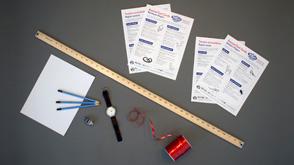Animal-ympics
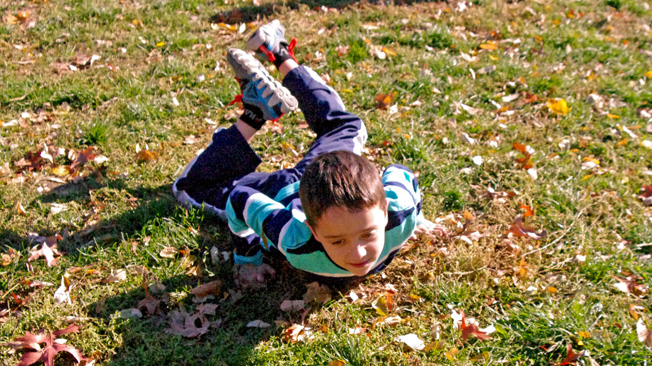
What Is This Activity?
How do animals' movements help them survive? Kids compete in a series of events to compare their movements to those of animals and then play a game to model how traffic can impact animals' lives.
Introduction
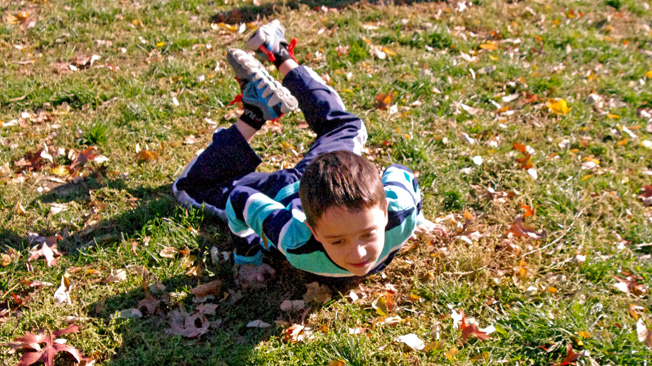
Learning Goals
Big Science Idea:
- Animals move in different ways from one place to another to find food, water, and shelter, and to avoid danger.
Skills kids will use to investigate the idea:
- Model and compare various ways that animals move and communicate the survival advantages of animal locomotion
- Make predictions and use math to estimate, measure, and compare distances and speeds
- Model the hazardous effects of traffic on animals and discuss solutions
How Do You Get Ready?
- Read the activity and gather the materials.
- You don't have to do all the activities if time is short. If there are two educators, split the group in half and run events simultaneously.
- Print the "Animal Fact Cards" on sturdy paper or cardstock, cut them out. Optional: Either laminate or secure the cards between pieces of clear contact paper or shipping tape.
- Scout out a suitable place, such as a park, schoolyard, basketball court, or other open area. Mark off the boundaries of the playing area for the "Animal Crossing" game with chalk, string, or yarn.
- Troubleshoot any safety concerns (traffic, poison ivy, sharp objects, etc.). For the Snail Superhighway contest, which involves crawling, be especially careful about removing harmful objects such as glass from the ground.
- Mark out a starting line at the edge of the area with chalk, ribbon, or yarn. It should be long enough for all the kids to line up behind it. Measure out one yard from the starting line and mark it off the full length of the starting line. Then, measure out 40 inches from the starting line and mark that distance with a four-foot line.
- Cut an 80-foot piece of string, ribbon, or yarn.
- If you don't plan to show "Squirrel for a Day," the video that is paired with this activity on the website, watch it ahead of time and jot down concepts to share with kids during the activity.
Warm-up 5-10 minutes
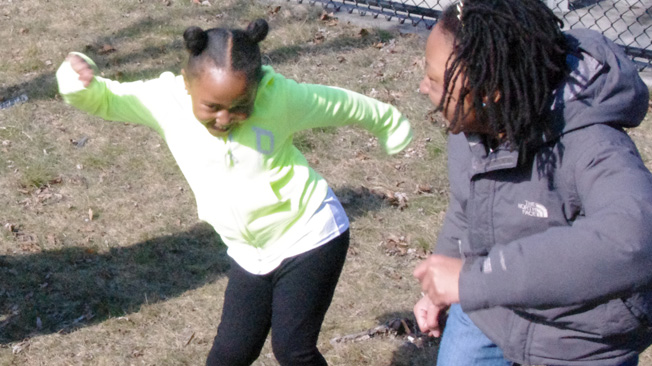
(Science Skills: Model and compare the various ways animals move)
Animal Charades. Kids move and act like a secret animal until someone guesses the animal's name.
- Each kid, in turn, thinks of an animal and whispers its name to you.
- Without speaking, each player moves and acts like that animal when it's his or her turn.
- The other kids mirror the player's movements as they try to guess the animal.
- The first kid to guess correctly takes the next turn. If no one guesses after about a minute, the player identifies the animal and chooses the next player.
- Wonder aloud: Why do animals move? Why not stay in one place, like a tree? Remind kids that they are animals too! (Animals move to find food, water, and shelter; to escape predators; to find a mate; to practice skills and exercise muscles; and sometimes to play.) Why do animals move in so many different ways? Are some ways of moving better than others? Listen to the kids' ideas and tell them they will learn more in the activities to follow.
Activity 40-50 minutes
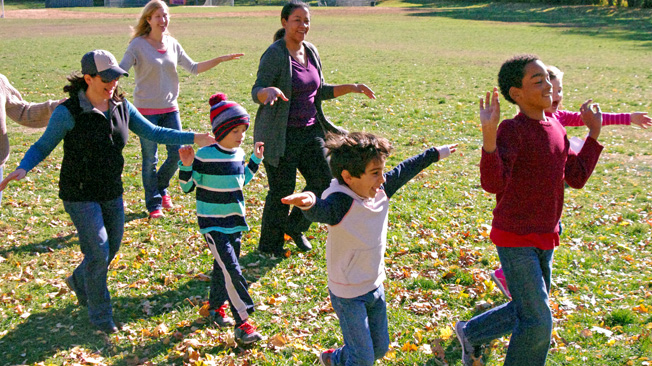
Animal-ympics Contest
(5 minutes)
(Science Skills: Communicate ways that animals move)
- Introduce the science term animal locomotion, or how animals move from one place to another.
- Ask: How many ways do animals move? Remind kids of the animals in the warm-up activity, if you did it—or have them think about the animals that live in your city or town. (Animals that walk or run on two legs, walk or run on four legs, fly, slither, crawl, roll, hop, jump, waddle, paddle, swim, etc.)
- Blow the whistle and announce that the Animal-ympics are about to begin! Tell kids they are about to compete in an animal locomotion contest. They are going to see if they can move like some common city animals.
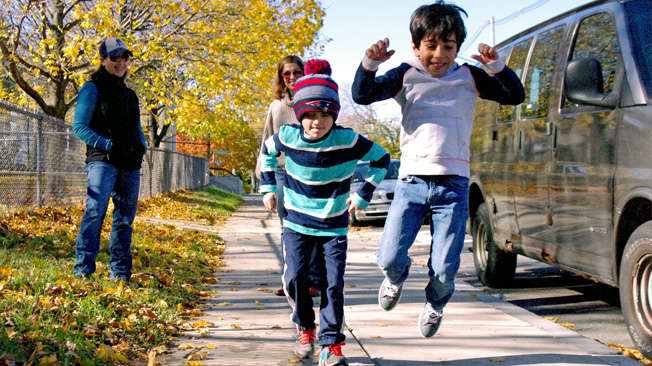
Event 1: Grasshopper Long Jump
(about 10 minutes)
(Science Skills: Make predictions and use math to estimate, measure, and compare distances; communicate survival advantages of jumping far)
- Demonstrate a standing long jump (also called a broad jump):
- Stand behind the starting line with feet planted firmly.
- Pump your arms forward and back dramatically, bend your knees, and jump as far as you can.
- Use the measuring tape or yardstick to determine the distance from the starting line to where you land.
- Have a volunteer read aloud the Grasshopper Animal Fact Card. Ask: How long is a grasshopper? Have kids show you two inches with their finger and thumb.
- Show kids the 40-inch distance you measured out ahead of time. Explain that's how far a grasshopper can jump (without flying). Ask: About how many grasshoppers long is that distance? Let kids guess before revealing the answer: 20 grasshoppers.
- How do the kids measure up to the grasshopper? Ask: How far do you think you can jump? Have all of them line up in back of the starting line and jump as far as they can. Encourage them to be dramatic too.
- Ask: Did anyone jump as far as their height? Two times their height? Do you think you could jump a distance 20 times your height? Point out that would be about an 80-foot jump! Ask two volunteers to stretch out the 80-foot string to demonstrate the distance.
- Show the picture of the grasshopper and ask: How do you think grasshoppers jump so far? (Lightweight, very long legs compared to body. Explain that the back legs have muscles that act like a rubber band—stretch and then snap!) How does being champion jumpers help grasshoppers? (They escape predators by moving fast and far over tallgrass.) Explain that grasshoppers can also fly short distances, which extends their jumps even farther.
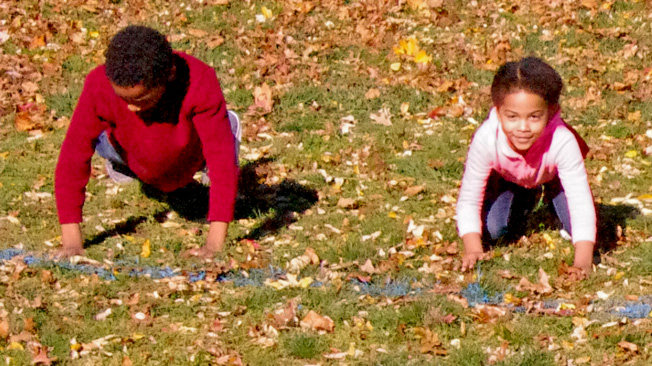
Event 2: Coyote Sprints
(about 10 minutes)
(Science Skills: Make predictions and use math to estimate, measure, and compare speeds and distances; communicate the survival advantages of fast locomotion)
- Demonstrate a fast 10-second run (called a sprint):
- Have a volunteer use the timer to time you.
- Stand behind the starting line (or use a sprinter's stance for more drama) and take off!
- As you run, pump your arms back and forth and raise your legs high, like an Olympic sprinter.
- Measure the distance you ran in 10 seconds.
- Have a volunteer read aloud the Coyote Animal Fact Card. Discuss: What else can travel 45 miles per hour? (Cars, for example.) Point out that the speed limit for many neighborhoods is much slower—25 mph.
- Can kids outpace a coyote? Ask: How far do you think you can run in 10 seconds? Have kids line up along the starting line for a 10-second race. Optional: Give each kid a piece of chalk to mark their stopping point.
- Start the timer and shout, "RUN!"
- At 10 seconds, shout "FREEZE!" Kids should instantly stop in place and optionally mark their spot with chalk. If some kids keep moving, start the race again.
- Measure the distance of the farthest kid and say it aloud. Explain that a coyote traveling at its top speed would have run about 660 feet in that time! That is as long as a 60-story apartment building is tall!
- Discuss: Why does a coyote need to be speedy? (To survive! Speed helps them catch fast prey such as rabbits, rats, mice, squirrels, birds, etc.) Explain that it's estimated there are between 1 million and 10 million coyotes in cities across the United States.
- Ask: Why would coyotes live in a city or town instead of the wild? (Plenty of food; almost no predators, such as wolves, bears, or mountain lions.)
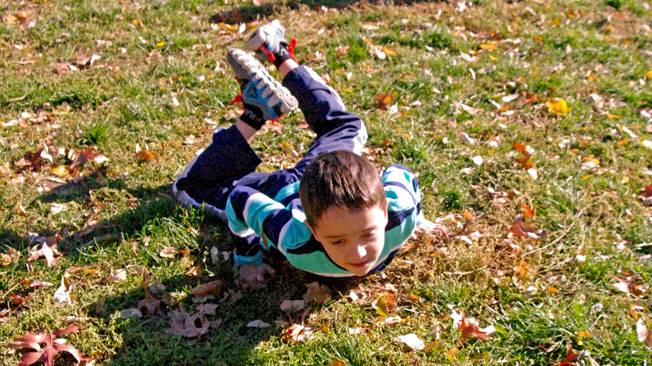
Event 3: Snail Superhighway
(about 10 minutes)
(Science Skills: Make predictions and use math to estimate, measure, and compare speeds and distances; communicate the survival disadvantages of slow locomotion)
- Demonstrate how to slide like a snail (or take tiny baby steps if the playing surface is unsuitable): Lie on your stomach with your legs stretched behind you. Perform a modified crawl in which you lift your body onto your forearms and then use them to "walk" forward. It's okay to push off with your toes if you need to.
- Have a volunteer read the Land Snail Animal Fact Card.
- Ask kids to predict: How long would it take you to travel one yard like this? Why?
- Point out the one-yard line from the starting line. Ask kids to line up behind the starting line on their stomachs.
- Start the timer and say "SLIDE!" As soon as the first kid's feet pass the yard mark, shout "STOP!" Announce the time, likely around 10 seconds.
- Were their predictions close? Explain that in 10 seconds, a typical snail travels a little less than half an inch! They lay down a trail of mucus, a natural slime, to make sliding smoother.
- Discuss: How is being slow a disadvantage to survival? (Easier for predators to catch; takes longer to find food, water, shelter, and mates.) So how do snails survive? What other defenses do they have? (Strong outer shells discourage some predators; they are mostly active at night under cover of darkness.)
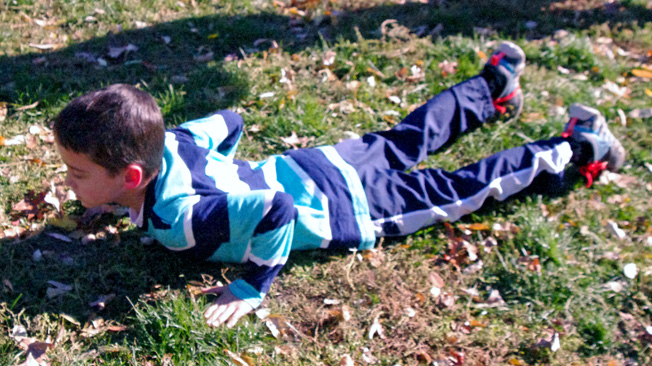
Event 4: Hummingbird Flap-Off
(about 10 minutes)
(Science Skills: Make predictions and use math to compare speeds; communicate the survival advantages of flying acrobatically)
- Demonstrate how to fly like a hummingbird: Flap your arms as fast as you can while moving in quick circles.
- Have a volunteer read the Hummingbird Animal Fact Card. Ask: Could you flap your arms 3,000 times in 60 seconds? Have the kids predict how many flaps they can do in 60 seconds and write the number in their notebooks.
- Have kids pair up: One kid will flap while the other counts.
- Start your timer, and say "FLAP!"
- At the one-minute mark, say "FALL!" Flappers should stop and fall over, as if they are exhausted.
- Have the pairs switch roles in the Flap-Off.
- Make sure they record their scores in their notebooks. Ask: Did anyone come anywhere close to 3,000 flaps? How do your arms feel? How long do you think you could flap before getting tired?
- Discuss: Point out that no other bird flies like a hummingbird—hovering, darting, and flapping so rapidly. How does fancy flying help them survive? (Their speed and ability to change direction quickly make them hard to catch; hovering lets them drink nectar from flowers—and bird feeders—while in air.) Any disadvantages? (They spend a huge amount of energy and so must eat their body weight in nectar each day.)
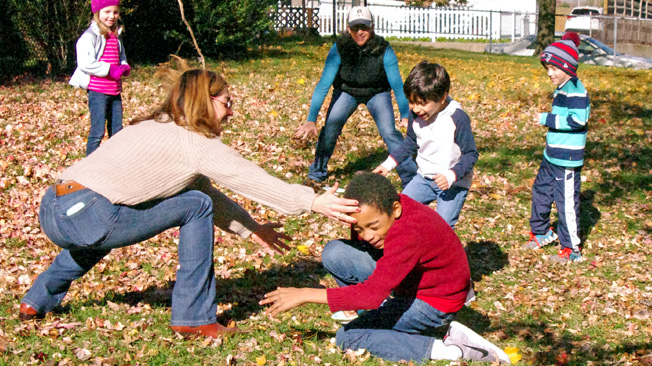
Animal Crossing Game
(about 10 minutes)
(Science Skills: Model the hazardous effects of traffic on various animals on the move)
- Ask: What challenges do animals face when they move around a city or town in search of food, water, and shelter? (Traffic on roads, for example.) Which of the animals in today's contest would have the hardest time crossing a busy road? (Slower ones, like the snails, and those that can't fly.)
- Divide the group in half, into Cars and City Critters. Among the City Critters, designate coyotes, grasshoppers, and snails. Hummingbirds can fly over traffic!
- Divide the Cars in half and ask them to stand in line, single file, on either end of the area. Explain that they will jog across the field, passing each other on the left like traffic on a two-lane road, and then jog back across the field in the opposite "lane." Remind them to stay within the boundaries.
- On your signal, the City Critters try to "cross the road" —sprint like a coyote, jump like a grasshopper, or take sliding baby steps to model a snail's pace.
- Cars should tag the Critters that get within their reach—without chasing them. Cars should maintain their speed and direction.
- Discuss: How many critters crossed the road without getting tagged? (Hit by cars?) Of those that didn't make it, which animals were they pretending to be? (The snails will likely have high casualties.) If you have time, have the City Critters and the Cars switch roles.
Wrap-up 5-10 minutes
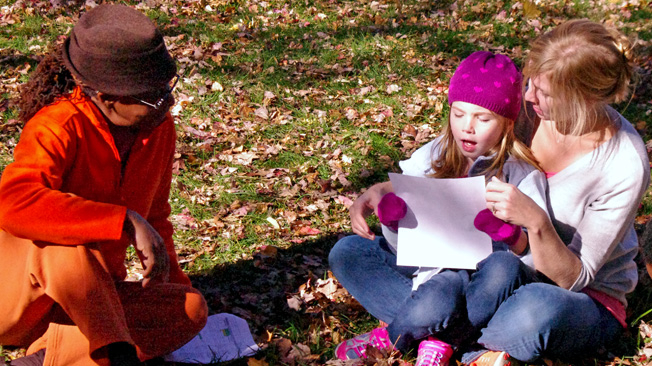
(Science Skills: Communicate how locomotion help animals survive; discuss solutions to traffic accidents involving animals)
- Ask: Which was your favorite event? What other animals could you to go up against in a locomotion contest?
- Discuss: How does locomotion help animals survive? (Catch prey or escape from predators; look for food, water, and mates; avoid traffic accidents.) What could city and town planners do to reduce car accidents involving animals? (Speed limits, fences or other barriers, animal corridors that take them over or around roads, etc.) If kids struggle for ideas, remind them of some of the reasons for accidents: Cars move very fast compared to most animals; animals are hard to see; animals have to move around to survive and can't always avoid roads.
- If you haven't already, send home "Explore Animals Around You" handouts to provide families with ideas on how to continue investigating animals together.
Explore Some More
Stash the Acorns Game
Two kids play Crows who eat acorns, and the others play Squirrels collecting acorns for the winter. The point: Animals in the same habitat sometimes compete for food.
- Setup: In the center of a play area, set out a pile of "acorns" (at least two per kid). Use bean bags, dry pasta, or other small objects. Have the Squirrels write their names on paper plates. Place the plates around the edge of the play area.
- Rules: On your signal, the Squirrels start running to the pile, taking one (and only one!) acorn, and putting it on their plate. Meanwhile, the Crows take one acorn from any plate and return it to the pile. Kids should move like their animal, flapping wings like a crow, scurrying like a squirrel.
- To win: The first Squirrel to collect five acorns wins the game.
More Amazing Animal Feats
Hold an Animal-ympics II to explore endurance, strength, balance, and other feats. Some ideas:
- Flamingo: Stand on one leg as long as possible.
- Squirrel on a wire: Walk in a straight line without stepping off.
- Bat: Hang from the monkey bars as long as possible.
- Ant: Carry a gallon of water as far as possible.
- Hummingbird: If you have computer access, have kids play the "Beat the Beats" finger-clicking game at the Cornell Lab of Ornithology website.
- Check out other animal record-setters at the National Wildlife Federation's Animal Olympics site.
Explorer's Notebook
Use the template provided: Have kids locate or think of an animal in your outdoor space and create an Animal Card. They should make a drawing, estimate size, and make educated guesses about locomotion, food, habitat, and one amazing fact. (They can research later to confirm, if needed or desired. Guiding questions:
- What kind of animal is it? How many legs does it have? How does it move? What color is it? How big? What's surprising or interesting about its looks or behavior?

